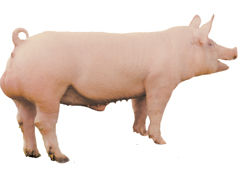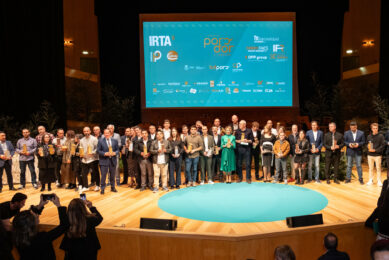Towards ‘genetics à la carte’

Research has revealed collateral effects of genetic selection programmes aimed at maximising litter sizes. Selecting for piglet survival rates may even yield a more balanced approach, but the question remains – does this also yield pigs the market is waiting for?
| The Topigs Tempo, a Large White boar line, exels in the progeny vitality and feed intake. | The Topigs Top Pi, a Pietrain line, is very lean and yields a high meat percentage. |
Pigs with high growth rates – efficient at feed conversion, sows with large reproduction capacity and slaughtering animals with both great meat quantity and quality – are these the ideal pigs?
All these traits are obviously important, and are also essential to answer to the demands of specific markets. However, it doesn’t stop when all these criteria are met, says Dr Antonio Muñoz Luna, veterinarian and professor at the University of Murcia, Spain.
“In the last few years, the zootechnical parameters which influence swine production have evolved considerably. Undoubtedly, most of them significantly increased production efficiency. Nonetheless, we are forced to recognise that those programmes aimed exclusively at increasing litter size are facing a whole series of collateral effects. Among them we notice a high percentage of stillborns and also a high post-partum mortality rate.”
Muñoz explains that it is necessary to develop a whole new concept of genetic improvement; one which is balanced, and is not exclusively aimed at cost reduction, as has happened in the past. “It is necessary to stop on the way, to reflect on modern pig production over the last 30 years and to plan a future which is more coherent with sanitation, animal welfare and environmental protection.”
Muñoz’s knowledge of the issue stems from studies he carried out over the last years aimed at reducing those collateral effects. “Companies managed to get a significant increase in the number of weaned piglets/ sow/ year, which is what producers really cared for. I see it in a slightly different way: I believe that piglet survival is most important.”
Looking at the past
The 80s and 90s were distinguished by the combination of three trends: litter size (expressed in number of live born piglets), growth speed (feed conversion capacity) and percentage of lean meat (decrease in bacon fat depth).
However, undesirable characteristics have been found in both the sows and in the meat in all genetic selection programmes which focused exclusively on a simple combination of the three characteristics above. For example, hyperprolific females started to show some collateral effects such as a decrease of average piglet birth weight and an increase in litter heterogeneity, both at birth and weaning. Also found was an increase in the number of low weight piglets, with less than 800 g. “Those circumstances, allied to health imbalances, have resulted in losses during the nursing phase. Consequently, the producers had to increase the nursing period, to try to correct, through management, such inefficiency, which did not exist 20 years ago. We were then talking of precocious weaning, below 21 days of age.”Muñoz says that although the increase in annual feed consumption of sows resulted in a larger weight of weaned piglets per year, the females started to show digestive problems. This resulted in more sow losses and in an increase in production costs, due to the need to replace the breeding stock.
“Nowadays we have to carefully evaluate all those issues, and especially their impact on the composition of production costs of piglets at weaning phase. We have undoubtedly seen a significant increase in the number of born and weaned piglets per sow per year over the last few years. However, it is also certain that other, negative parameters have also increased. Among them we have the percentage of stillbirths, losses during the weaning phase, sow deaths, female annual feed consumption and an increase of the nursing phase. This is clearly not the desired scenario.”
It is here that his work comes in. He first compared the main production parameters over the last three decades, and their impact on production costs (see Table 1 of collateral effects).
He was then able to confirm the hypothesis that all the improvement from a significant prolificacy increase will be cancelled, from an economic point of view, by the negative impacts of the side effects, related to litter size.Besides the genetic aspects, there is one other issue Muñoz regards as important, when it comes to reducing production costs: Feed conversion. “There was a continuous progress in feed conversion in all genetic lines. So much so that nowadays we need to measure individual feed consumption to be able to identify a genetic improvement in this feature. Feed conversion is so important because, alongside numeric productivity, it is of large economic importance for reducing production costs.”
Ideal selection
One of the characteristics Muñoz considers paramount when choosing a genetic improvement programme is the Benefits Optimization criterium, aimed at increasing income and reducing costs. Muñoz says: “One discards the idea that production efficiency is measured by the amount of swine weight sent to slaughter, replacing it by high quality meat weight sent to slaughter.”
In order to increase gains, producers need to select the parameters by new quantity and quality parameters. The first refers to the weight of valued cuts, such as loin and ham, which refers to percentage of lean meat. Quality, on the other hand, is evaluated through percentage of intramuscular fat, colour and water holding capacity.
When the issue is reducing fixed costs, one needs to pay attention to numeric productivity, litter size, piglet survival and vitality. In the variable costs, feed efficacy must be observed, primarily through feed conversion rate and daily weight gain.
In spite of the adverse collateral effects, Muñoz says that the current genetic science has powerful tools at hand to get a more satisfactory result. “We can design animals à la carte, so to speak, animals which can answer the needs of specific or differentiated markets.”
Correcting the imbalances
The late 90s were marked by a debate over litter size increase, as the growth of the number of liveborn piglets led to increased mortality, due to low birth weights. “Even after correcting birth weight, we found other issues to solve, such as survival in the delivery and weaning,” says Muñoz.
An experiment by Dr Egbert Knol, Wageningen University & Research Centre, the Netherlands, analysed piglet survival based both on female and male genetics. Muñoz says, “The survival of a piglet is hereditary, controlled by its own genes, its mother’s genes (uterine quality) and by the genes of the female that feeds it (maternal ability). In those lineages with high genetic value we had litters showing higher survival rate in the pre-weaning phase, more uniform litter size at birth, and there was no reduction in litter size or in birth weight.”The study also pointed out that those piglets with higher fat and glycogen reserves, which protect neonatal piglets from hunger and cold in those cases of late or reduced colostrum intake, showed better performance in those lineages of High Genetic Value.
“The piglets with low birth weight probably accrue benefits from higher energy reserves, given they show a higher risk of late or reduced colostrum intake because of competition with heavier piglets on the udder,” Muñoz explains.The weight of some important organs for swine health and development was also evaluated both in the litters with high and low estimated breeding value (EBV). They found similarities in both lineages for stomach, lungs and heart weight. However, the liver and small intestine were heavier in the high EBV animals, showing thus a higher capacity for digestion and metabolism of nutritious substances.
The selection for survival produces piglets that eat more, grow faster and have more fat in the final phase, as well as at birth.The question remains: Is this what consumers want? Muñoz says. “High fat figures in finisher pigs conflict with consumer desires, as they prefer lean meat. However, it is possible to produce genetics à la carte, according to what the market desires. I believe that the challenge for geneticists is to design a selection strategy which ensures both the genetic progress in piglet survival and, at the same time, fulfill the consumers’ desire for lean meat.”
caption: The Topigs Tempo, a Large White boar line, excels in the progeny vitality and feed intake.
caption: The Topigs Top Pi, a Piétrain line, is very lean and yields a high meat percentage.











